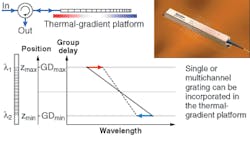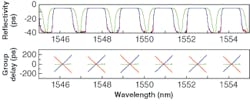
YVES PAINCHAUD, CARL PAQUET, AND MARTIN GUY
As data rates of telecom systems increase from 10 to 40 Gbit/s, new technical challenges appear, including the adverse effects of signal broadening caused by chromatic dispersion. This physical phenomenon originates from the wavelength dependence of the propagation velocity in the transport optical fiber. In such a material, the blue part of an optical pulse propagates faster than its red part, resulting in progressive pulse broadening.
Fortunately, it is easy to recompress the optical pulses by providing a device that does just the opposite: providing a longer propagation time for the blue part than for the red part of the optical pulses. This scheme is referred to as dispersion compensation and actually works better than trying to eliminate the chromatic dispersion in the transport fiber. For example, dispersion-shifted fiber (DSF) was developed to provide negligible chromatic dispersion, but brings new problems, including larger nonlinear effects.
Until recently, dispersion compensation was primarily achieved using dispersion-compensating fibers (DCFs). Unfortunately, these bulky DCFs suffer from high insertion loss and sensitivity to nonlinear effects, prompting system manufacturers to look for alternatives.
Fiber-Bragg-grating compensators
Proposed for dispersion compensation two decades ago, a fiber Bragg grating (FBG) consists of a longitudinal index modulation in the core of an optical fiber.1 The light is reflected by the FBG when its wavelength satisfies the interference condition dictated by the modulation period. For dispersion-compensation purposes, the modulation period varies along the fiber axis such that the blue part and red part of an optical pulse are reflected back at the far and front parts of the FBG, respectively.
Since the FBG-compensation idea was first conceived-and especially over the past five years-significant advances have been made. This technology is now mature enough for dispersion compensation and represents the first deployed compensation technology besides DCF. The major advantage of FBG technology is its ability to provide tunable dispersion compensation-a critical feature required for 40 Gbit/s communication systems that cannot be met by DCF.
High complexity; simple manufacturing
One of the biggest advances in FBG technology is the upgrade from single-channel to broadband operation, thanks to the development of multichannel FBGs.2 Many channels can be tailored to provide dispersion opposite to that of the transport fiber for which a wavelength dependence is observed. These FBGs conveniently provide dispersion and dispersion-slope compensation for standard single-mode fibers (SSMFs) and for nonzero dispersion-shifted fibers (NZ-DSFs).3, 4 Although a quite complex FBG is required to include all these advances, this complexity can be transferred into a phase mask for efficient manufacturing.5
A phase mask to fabricate FBGs consists of a fused-silica plate containing a series of corrugations. In the writing process, an optical fiber is positioned in close proximity to the phase mask. When an ultraviolet beam passes through the phase mask, it produces an interference pattern-according to the phase-mask corrugations-that permanently creates a modulation index in the fiber core, thus forming the FBG. In a complex writing scheme, some additional features can be added to the FBG. But when using a standard simple writing scheme, FBGs can be viewed as replicas of a master: the phase mask.
FBGs in 10 Gbit/s systems
Compared to DCF, FBGs are low-loss, compact, and provide no nonlinearity. The in-line use of FBG-based dispersion compensators has been demonstrated in metropolitan and regional links up to 1500 km.6, 7 The low-loss nature of FBG-based dispersion compensators compared to DCF-based compensators is best illustrated for 10 Gbit/s applications (see Fig. 1).
Dispersion-compensating fiber is typically used in-line, at the middle of dual-stage erbium-doped fiber amplifiers (EDFAs). The EDFA amplification counteracts the transport-fiber attenuation and the DCF insertion loss (typically around 7 dB per module). The low insertion loss of FBG-based dispersion compensators (around 2 dB) allows a significant reduction in the amplification requirements such that single-stage or variable-gain EDFAs are typically sufficient. This decrease in the amplification requirements reduces the system cost and can provide an improvement of the optical signal-to-noise ratio (OSNR).
FBGs in 40 Gbit/s systems
Chromatic-dispersion management is significantly more stringent at 40 Gbit/s than it is at 10 Gbit/s. In particular, the dispersion must be optimally tuned at the receiver on a per-channel basis. This is accomplished using a tunable dispersion compensator.
Unfortunately, DCF does not offer any possibility for dispersion tuning. But FBG-based tunable dispersion compensators represent a logical alternative as an extension of already deployed and proven fixed-FBG-based compensators. Furthermore, FBGs have the advantage of providing a wide tuning range over a broad channel bandwidth when compared to other dispersion-compensation technologies such as etalon filters, planar-lightwave-circuit (PLC)-based compensators, and virtually imaged phased arrays (VIPAs). Although used on a per-channel basis, the multichannel feature is important because colorless operation is required for inventory purposes.
The dispersion provided by the FBG can be tuned by imposing a thermal gradient along the fiber axis.8 Over one channel of a multichannel FBG, the group-delay spectrum is larger for the blue part of the channel, thus providing the required function (see Fig. 2). The dispersion value is given by the slope of the group delay versus wavelength. When an FBG is cooled, its period shrinks and the reflectivity it provides occurs at a lower wavelength. The opposite effect occurs when the FBG is heated. As a result, a thermal gradient applied over the FBG allows dispersion tuning over a certain range around its nonthermally perturbed value.From component to intelligent module
The FBG tuning platform uses thermoelectric coolers that must be controlled properly to obtain the desired dispersion adjustment. The heat produced in the device must also be managed for proper operation. Fortunately, the control electronics and appropriate thermal management have been engineered to obtain intelligent, tunable dispersion-compensation modules incorporating FBGs. Packaged modules can be easily integrated by system designers and are conveniently controlled through a communication port.
Bright future for FBGs
As the optical performance of FBG-based dispersion compensators continues to improve, these devices may move beyond 10 Gbit/s and 40 Gbit/s deployments for consideration in long-haul links as well. The cost-effectiveness associated with the reduction in amplification requirements for 10 Gbit/s systems, as well as the per-channel adjustment of the residual dispersion at the receiver for 40 Gbit/s systems, are critical functions of FBG-based dispersion compensators that will make them an attractive solution for system designers now and into the future.
REFERENCES
1. F. Ouellette, Optics Lett. 12(10) 847 (1987).
2. J. Rothenberg et al., Proc. Optical Fiber Conf. 2002 (OFC 02) 575 (2002).
3. M. Morin et al., Proc. OFC 04, paper WK1 (2004).
4. Y. Painchaud et al., Proc. OFC 06, paper OThE2 (2006).
5. M. Guy et al., Proc. Bragg Gratings Photosensitivity and Poling in Glass Waveguides Conf. 2003, 269 (2003).
6. Y. Painchaud et al., Proc. European Conf. on Optical Comm. 2006 (ECOC 06), postdeadline paper Th4.2.7 (2006).
7. H.S. Fews et al., Proc. ECOC 06, paper Th3.2.5 (2006).
8. R.L. Lachance, S. Lelièvre, and Y. Painchaud, Proc. OFC 03 1,164 (2003).
9. A.W. Farr and É. Pelletier, Fiberoptic Product News (May 2004).
YVES PAINCHAUD and CARL PAQUET are product managers and MARTIN GUY is vice president of product management and technology at TeraXion, 2716 Einstein St., Quebec City, QC, Canada, G1P 4S8; e-mail: [email protected]; www.teraxion.com.

